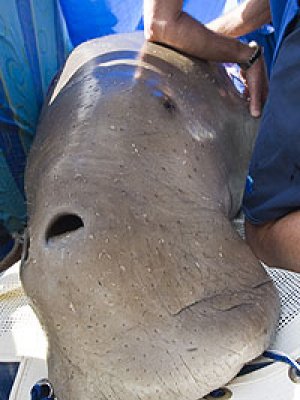
Biologists from the University of Queensland have teamed up with Sea World and Sydney Aquarium to assess the health and reproductive status of wild dugongs in Moreton Bay this week.
Leader of the UQ Dugong Research Team, Dr Janet Lanyon from UQ's School of Biological Sciences, said determining reproductive status of individuals was one of the most important factors for population modelling and effective management of a vulnerable species.
Dr Lanyon said the short-term goal of the study was to determine the most reliable method for indicating hormone levels in the dugong, while the long term goal was to determine critical reproductive parameters in wild dugong populations.
“Once we understand seasonality and timing of reproductive patterns, we will be able to develop useful models of population dynamics for vulnerable dugongs,” she said.
“Assessing the health of these animals is a valuable tool in determining the fitness of wildlife populations; and marine mammals such as dugongs may be used as sentinels for emerging threats to coastal seagrass ecosystems."
The team of researchers are out in the field in Moreton Bay this week sampling a selection of dugongs, which are representative of both sexes and from adult, sub-adult and juvenile size classes. The plan is to capture up to 17 dugongs over seven days taking approximately 30-40 minutes to sample each animal.
Researchers are collecting blood to look at haematology, blood bio chemistry, immune factors as well as screen for disease. Urine and faecal samples are also being collected to be cultured for microbes and screened for parasites and zoonotic disease.
Dr Lanyon said blood and urine sampled from this study was important because it has been shown to represent active circulating hormone levels in other species such as Florida manatees.
She said the aim of the research was to validate the use of blood, faecal, urine, vaginal mucus, tears and exhaled air samples to measure reproductive hormone concentrations and blood parameters in dugongs.
As well as collecting samples, comprehensive medical examinations by biologists and vets are being carried out to assess the body condition of the animals, including girth and weight measurements.
“The hormone data will be used along with gender, body size and social association data gathered during mark-recapture studies, to determine the reproductive status of individual Dugongs,” she said.
Sea World Director of Marine Sciences, Trevor Long said the sampling involves lifting wild dugongs out of the water to take a comprehensive series of tissue and excreta samples to measure reproductive hormones plus an abdominal ultrasound to confirm reproductive state.
Mr Long said a specially designed stretcher is used to hoist the animals from the water onto the deck of research vessel Sea World One.
“This is a very exciting study, and allows us to capture data that will help to establish reference blood parameters for the species”, he said.
Mr Long said the dugong was a major conservation priority for Sea World.
“The Sea World Research and Rescue Foundation’s work in past years has resulted in the rescue and rehabilitation of dugongs Pig and Wuru, who now reside at the Sydney Aquarium," he said.
"Along with Sydney Aquarium, a partnership with dugong experts such as Dr Lanyon and the University of Queensland is an ongoing priority for Sea World."
Sea World and the Sydney Aquarium this year provided generous support to the UQ Dugong research team. Sea World also provided the use of Sea World One as the main research vessel and base in Moreton Bay this week.
Media: Andrew Dunne at UQ Communications (07 3365 2802) or Wendy Chettle at Sea World (07 5588 2275).
.jpg)


